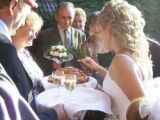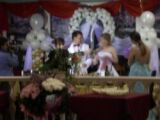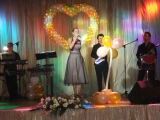 |
|
|
|
|
 |
|

 |
 |
 |
 |
 |
 |
|
|
 |
Реклама и счётчики
Вы сейчас находитесь ТУТ : ГЛАВНАЯ --> ПОЛЕЗНОЕ --> ПРАЗДНИКИ --> СВАДЕБНЫЕ ТРАДИЦИИ СТРАН МИРА --> English wedding traditions
В помощь тем, кто собирается проводить праздник самостоятельно
СВАДЕБНЫЕ ТРАДИЦИИ СТРАН МИРА
English wedding traditions
-
Confetti
In Pagan times, rice and grain was usually thrown at the bride and groom to represent fertility and continuity. This has been adapted to paper and dried petals. -
Wedding Cakes
The wedding cake dates back to the Middle Ages when the bride would carry a bouquet of wheat and scatter the grains after the ceremony. This was then made into cakes and broken over the Bride's head to ensure good luck and fertility. The wedding cake is cut by the bride and groom to represent sharing their new life together. All the guests should eat some to ensure good luck. A single woman can place a piece of wedding cake under her pillow and should dream of the man she is going to marry. If you have a very tall, three tiered cake the bride and groom should kiss over the cake and if they don't knock it over they will have a life of good fortune. - Tying shoes to cars
Shoes were a powerful symbol in ancient times. In Egyptian society, shoes were exchanged when they exchanged goods and the father of the bride would give the groom-to-be her shoes as confirmation of the contract. The shoe is also a symbol of fertility and a sign of passing responsibility for his daughter onto her husband. In Anglo-Saxon times, the groom would tap the heel of the bride's shoe to show his authority over her. - Honeymoon
The tradition of the honeymoon comes from the time when the groom would kidnap his bride to be and carry her off to a secret hiding place where he would keep her for a set period of time until, depending on the laws/traditions at the time, her ownership would pass to him. - Returning Home
The bride should be carried over the threshold by her groom because the threshold of houses were supposed to contain evil spells. The groom had to carry his bride over the evil spirits in order for her to start her new life spell free. It was also considered very bad luck if the bridegroom should trip or fall. - The marriage ceremony
During the service the groom stands on the right of the bride This dates back to the days when men wore swords. If any man challenged the groom to his right to his bride he could draw his sword with his right hand while still holding hers with his left.The taking of each others right hand as part of the ceremony is because the open right hand is a symbol of strength, resource and purpose. The coming together of both right hands symbolises that both the bride and the groom depend on each other and the resources that each brings to the marriage. It also represents the merger of their lives together into one. - The journey of the bride to the church
This is an important ritual when the bride must look out for 'lucky omens'. You must see a rainbow, have the sunshine on your back, have a black cat cross your path and be greeted by a chimney sweep. 'Bad Omens' include seeing a pig, hare or lizard running across the road, an open grave, or monks or nuns as they foretell barrenness and a life dependent on charity. - Seating in the Church
The bride's family sits on one side of the church whilst the groom's family sits on the other. This goes back to the time when a girl of one tribe would be offered by her father as a peace offering to another tribe. The tribes had to be kept separate in case someone started a fight. - Bridesmaids
Because of the susceptibility of the bride to evil spells and in order to confuse the spell landing on the bride, her best friends would dress in the same clothes as herself - so the evil spirits would not know on which person to land. - Best Man
The best man originates from the time when a bride to be was often 'kidnapped' from her family and the groom would take his very best friend who would help and support him in the event of a fight.
-
Victorian dressing rhyme
Something old is usually something belonging to a grandparent or parent and shows the continuity of 'family' - although the bride is leaving her old family behind she is showing she will still remember them. Something new represents the new life the bride is entering and the hope for success and good fortune. Something borrowed should be something borrowed from a family member or an already happy bride and is supposed to pass on good luck. The item must be given back or bad luck will follow. Something Blue - blue is a sign of fidelity and constancy. The custom of wearing a blue ribbon in a bride's hair began in ancient Israel and symbolised fidelity. Silver Sixpence in her shoe. A silver sixpence is considered a lucky charm and in olden times silver was ascribed with healing powers. It is often interpreted as bringing wealth to the newly weds.
- Bridal Bouquet
Flowers played a very important part in olden times - the smell of the flowers were believed to ward off evil spirits and bring good fortune. During the plague in England people would wear pouches of flower petals around their necks so they would not be infected with the Plague believed to be carried by strong, bad smells. The throwing of the bouquet is a way of spreading the bride's good fortune and luck. Whoever catches it will be blessed with good luck and will be the next to marry.The choice of flowers in a bouquet is usually for visual purposes and to retain a'colour' theme for the wedding but all flowers have a meaning: Apple blossom - good fortune, Aster - daintiness, symbol of love, Bluebells - everlasting love, Blue Violets - faithfulness, Carnation White - honesty, Daisies White - loyalty/innocence, Forget-me-nots -true love, Gardenias - joy, Iris - wisdom, Ivy - fidelity, Lilies - innocence & purity, Lily of the Valley - happiness, Orange blossoms - fertility & purity, Orchids - beauty, Red Rose - passion/beauty. - Groom's Buttonhole
The Groom is supposed to wear a flower that appears in the Bridal Bouquet in his buttonhole. This stems from the Mediaeval tradition of a Knight wearing his Lady's colours, as a declaration of his love. - The wedding Dress -
Married in white, You have chosen a right.
Married in blue, Your lover is true.
Married in pink, Your fortunes will sink.
Married in green, You will not long be seen.
Married in red, You'll wish you were dead.
Married in yellow, Ashamed of the fellow.
Married in brown, You'll live out of town.
Married in grey, You'll live far away.
Married in black, You'll wish you were back. - The wedding Day
Monday for health,
Tuesday for wealth,
Wednesday's the best of all.
Thursday brings crosses,
And Friday losses,
But Saturday - no luck at all.
- The wedding Month
Married when the year's new he'll be loving, kind & true,
When February birds do mate you wed nor dread your fate,
If you wed when March winds blow joy and sorrow both you'll know,
Marry in April when you can Joy for Maiden & for Man,
Marry in the month of May and you'll surely rue the day,
Marry when June roses grow over land and sea you'll go,
Those who in July do wed must labour for their daily bread,
Whoever wed in August be many a change is sure to see,
Marry in September's shine your living will be rich and fine,
If in October you do marry love will come but riches tarry,
If you wed in bleak November only joys will come remember,
When December snows fall fast marry and true love will last.
-
The Morning Gift
In Medieval time a traditional wedding gift included small, valuable pieces of furniture which the groom might offer to the bride the morning after the marriage was consummated. This "morning gift," or thank-offering was given to compensate the bride for the loss of her virginity.
Cвадебные традиции других стран



